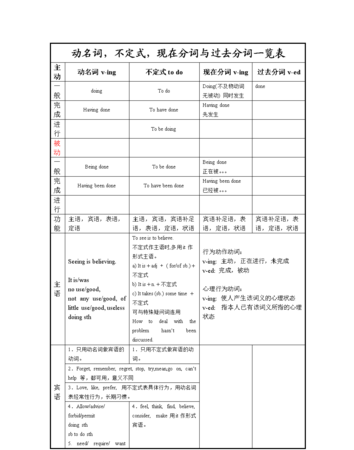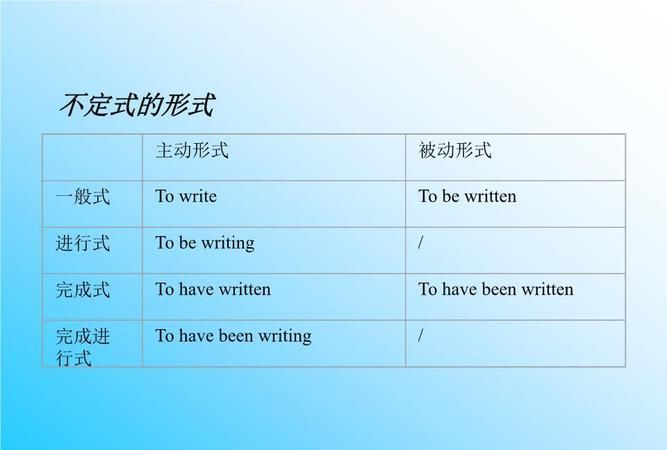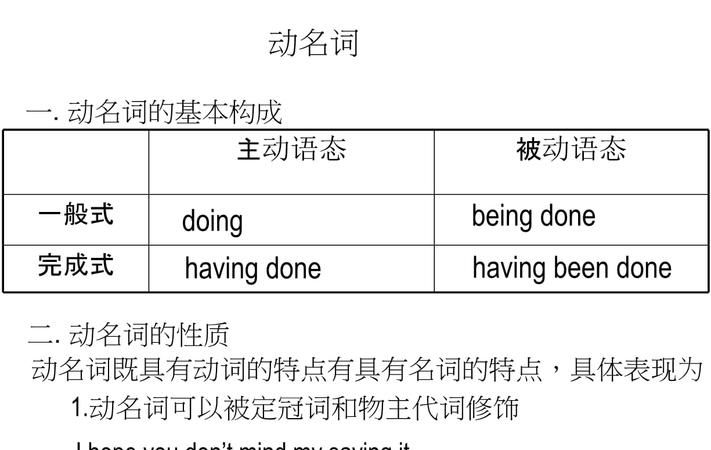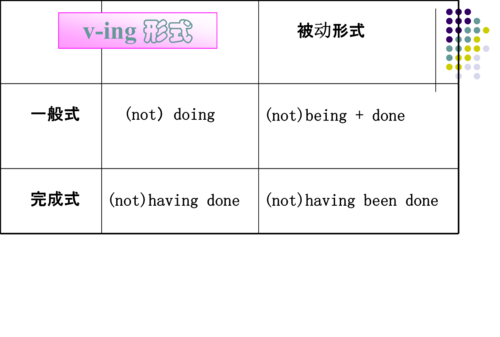本文目录
主动表被动的8种情况
在英语学习中,有许多地方用主动表被动,这对许多中国学生来说是一个难点,常常让他们感到不好学,不好掌握,在此小结一下 1、 Need, want, require(要求,需要), deserve(应得,值得), be worth值得),not bear(经不住) 后面接doing主动表被动。 The book is worth reading. 这本书值得一读。 The old building requires repairing. 这座古建筑需要修了。 These young seedlings will require/need looking after (=need to be looked after) carefully. 这些幼苗将需要小心的照管。 Your hair wants/needs cutting (needs to be cut). 你的头发该剪了。 2、不定式作定语,放在被修饰词后面,与前面被修饰的名词或代词有动宾关系,又在句子中与另一名词或代词有主谓关系,不定式要用主动表被动含义。 I have much work to do. 我有许多要做的事情。(与work有动宾关系,与I有主谓关系) Tom is looking for a room to live in. Tom在找一间住的房间。(与room有动宾关系,与Tom 有主谓关系) He has a family to support. 他要维持一个家庭。(与family有动宾关系,与he有主谓关系) 3、不定式修饰作表语和宾语补足语的形容词时,结构:主语+系动词+形容词 + 不定式; 动词+宾语+形容词+不定式。如果形容词是表示难易、利弊等含义,如 difficult, easy, comfortable(舒适的), convenient(便利的,方便的), hard, cheap, expensive, 等,不定式用主动表被动。 The question is difficult to answer. 这个问题很难回答。 The work is easy to do. 这项工作很好做。 I found the car comfortable to ride in. 我觉得这种车很好坐。 That makes poetry difficult to write. 那就使得诗很难写。 4、在be to结构中的一些不定式:这种结构中的不定式通常应用主动表被动。下列动词用不定式的主动形式表示被动意义: Who is to blame for starting the fire? 这场火灾应由谁负责? You are to blame for the accident. 你应为这事受动责备。 The house is to let.此房出租。 A lot remains to do.还剩下许多事情要做。 5、系动词没有被动形式,但有些系动词常表示被动意义。常见的有taste(吃起来), sound (听起来), prove(证明是), feel(摸上去感到), look(看起来),smell(闻起来)等,例如: Your reason sounds reasonable. 你的理由听起来很合理。 Good medicine tastes bitter to the mouth. 良药苦口。 6、一些与can''t(不能)或won''t(不会)连用的动词。常用的有: lock(锁住), shut(关上) , open(打开), act(上演), write(写),cut(砍,切),wear(穿,戴)等,用作不及物动词时,用主动表被动。例如: The door won''t open.这门打不开。 It can''t move.它不能动。 7、一些动词如sell(销售) , wash(洗), clean(打扫), burn(燃烧), cook(煮)等与副词如well(好), easily(容易地), perfectly(十分地)等连用 ,描会事物的特性,用主动表被动,结构是主语+动词+加副词。例如: The book sells well. 这种书很畅销。 These clothes wash easily. 这些衣服很易洗。 The pen writes well. 这笔很好写。 8、主语much, a great deal, little, what等,其表语如是不定式,则用不定式的主动表被动。 What is to do? 做什么? Much is to do. 太多要做的事。 9、在“there be”句型中作主语的定语如果现在分词时,所用的现在分词要用主动表被动意义。 There is nothing doing these days. 这些天没事干。 I see there’s a good idea planning. 我知道又在打好主意。 Exercises: choose the best choice. 1. There are many good films played by ChengLong that are worth __. A. to be seen B. being seen C. seeing D. to see 2. The food __ easily and sells __. A. cooks ; well B. is cooking; good C. is cooked; well D. cooked; good 3. The windows of the building can’t __., A. be closed B. close C. be closing D. closed Key: 1-3 CAB

英语中主动形式表被动意义
1、用某些不及物动词表示被动意义,如carry,cut,drive,iron,keep,lock,open,pick,read,sell,shut,tear,wash,wear,write等等。这类动词既能作及物动词,也能作不及物动词。作不及物动词时,形式上虽为主动,却表示被动意义。
2、某些感觉动词的主动态表示被动意义。
3、有少数动词(bind,cook,do,owe,print)的进行时有时有被动意义。在这种用法中,句子的主语都应该是指物的。
4、动词get,come,go之后接过去分词,表示被动意义。get的这种用法局限于口语和非正式的书面语言,更强调动作的结果而非动作本身,并常用来表示突发性的、出乎意料的偶然事件。而come和go常接含否定意义的过去分词。
5、在need(want,require,deserve,etc.)doing句型中,动名词(doing)相当于动词不定式的被动式(to be done),在意思上没有多大差别。
用法相似的结构还有bear doing,stand doing,be worth doing,习惯不用动词不定式。
值得注意的是,在be worth doing句型中,只能用动名词的主动式,而在be worthy to be done中,才能用动词不定式的被动式,两者不可混淆。
6、在某些性质形容词+动词不定式的句型中,其动词不定式的主动形式表示被动意义。
在这种句型结构中,动词不定式和主语的关系实际上是一种逻辑上的动宾关系,可以说是动词不定式作主语变换来的,相当于It's easy to answer the question.和It's difficult to understand that book.由于把动词宾语放在主语位置,所以和不定式的关系构成一种被动关系。
7、有些动词不定式不论用主动形式还是被动形式,动词不定式和主语的关系都是被动的。
8、以-able或-ible结尾的形容词可表示被动意义。
9、有些介词短语用作表语或定语时,可以表示被动意义。
10、在冠词the和a (an)后面只能用动名词的主动形式,这种名词化的动名词有时表示被动意义。
11、在某些名词词组中,表示动作的名词无疑具有动作的含义,往往可以表现被动意义,而这种被动意义与英语的被动结构无任何语法上的联系。

什么是主动形式表被动意义
一、谓语动词的主动形式表示被动含义
1、某些表示内在品质和性能的不及物动词的非进行体形式,如簂ock(锁), open(开), clean(弄干净, move(移动), wash(洗), sell(卖), write(写), weigh(称重), measure(量), read(读),shut(关), break(打碎), ride(骑), wear(穿), add up(加起来)等等, 句中往往用物作主语,且与一个行为方式状语(常用作行为方式状语的副词有:well, easily, long, fast, smoothly, rough等等)连或用于否定,表示某物展示出的该动作的某一特性,该特性促使动作得以实现或难以实现。例如:
Glass breaks easily. 玻璃易打碎。
My pen writes smoothly. 我的钢笔好写。
This kind of car sells very well. 这种车销路很好。
The material won’t wear. 这种材料不经久耐用。
The door won’t lock. 门锁不上。
注意:如果强调人为动作时,作及物动词用,可用被动态。如:
These books have long been sold out. 这些书早就卖完了 。
My watch was broken when I fell over. 我跌倒时手表摔坏了。
The address must be written on the envelope. 地址一定写在信封上。
2、某些谓语动词的进行体(主要是现在进行体)形式,这种句子的主语都是物,常见的这些动词有:do,
cook, print, copy, fill, build, work out, sell等。例如:
What is doing over there? 那边在干什么?
The bread is baking. 面包在烤。
The newspaper is printing. 报纸在印刷。
The plan is working out successfully. 计划在胜利实施。
注意:这种结构是早期英语遗留下来的一种用法,主要出现在某些日常用语和某些行业专门用语中,切不可随意滥用。
3、某些表状态的联系动词,如 look, smell, taste, feel, sound等等,它通常以形容词作表语,一般不跟副词,不与to be连用。
Cotton feels soft. 棉花摸起来很柔软。
He looks blue. 他显得神情沮丧。
This dish tastes delicious. 这道菜味道鲜美。
His conclusion sounded reasonable. 他的结论听起来很合理。
4、某些表示“发生”、“传播”的不及物动词,如:happen, occur, arise, turn up, take place,break out, spread等等。例如:
Great changes have taken place in China since the opening to outside world.自从改革开放以来,中国发生了翻天覆地的变化。
A great fire broke out in London in 1666. 1666年伦敦发生了一场大火。
二.非谓语动词的主动形式表被动含义
1)作定语用的不定式:
a. 该不定式与被修饰的名词、代词有逻辑上的动宾关系,且与句中主语或另一名词、代词有逻辑上的主谓关系。例如:
I have a book to read. (read与book有逻辑上的动宾关系,I 与read有逻辑上的主谓关系)
Can you give me something to read? (read 与something有逻辑上的动宾关系,me与read有逻辑上的主谓关系)
Mother always gives her little son some toys to play with. (play with 与some toys有逻辑上的动宾关系,her little son 与play with有逻辑上的主谓关系)
b. 尽管句中找不到不定筛的逻辑主语,但该不定筛与被修饰的名词有逻辑上的动宾关系,隐含“for sb.
to do”结构的意思:例如:
This is a difficult question to answer. ( for us / you to answer) 这是一难以回答的问题。
This is the best book to read. (for us / you to read) 这是一本最好阅读的书。
This will be a good opportunity to exchange experience. (for us / you to exchange) 这将是一个交流经验的好机会。
c. 在”with +o. + to do” 结构中。例如:
With nothing to do, I sat down to watch TV. 由于无事可做,我便坐下看电视。
He can’t go out with all these clothes to wash.由于有这么多衣服要洗,所以他出去不了。
注意:在 “There be”结构中,用来修饰主语的不定式可以是主动式,也可以是被动式,口语中多用主动式。例如:
There is so much work to do. (=to be done) 有那么多活儿要干。
There is no time to lose. (=to be lost)再也不能耽误时间了。
如果与句中主语、另一名词或代词无逻辑主谓关系,仍用被动式。例如:
Have you anything to be taken to Beijing ? (you与take无主谓关系)你有什么东西需要带到北京去吗?
There is only a reason for the book to be published? (the book与publish为动宾关系而不是主谓关系)这是该书出版的唯一理由。
2)作状语用的不定式
这种不定式作状语修饰作表语用的形容词,其逻辑宾语是作主语的名词, 友人称之为反射不定式。例如:
The sentence is very difficult to understand.
The problem is easy to solve.这个问题易于解决。
The work is impossible to finish without your help. 没有您的帮助,这项工作不可能完成。
这类形容词有:difficult, hard, easy, heavy, important, interesting, pleasant, nice,good,
impossible, strange等等。
注意:形容词long, short, high, low等后接不定式主动表被动时,其前必须加too 或在其后加enough。例如:
The poem is short enough to learn by heart. 这首诗很短能记住。
The fence is too high to jump over. 篱笆太高,跳不过去。
3)作表语用的不定式 例如:
The house is to let.此房招租。(广告用语)
He is to blame. 他该受到责备。
4)某些动词有-ing形式,如need(需要), want (需要),require (需要),stand (忍受,多用于否定),
bear (经受,多用于否定)等,而句子主语 (一般为物)为-ing分词的逻辑宾语。例如:
The house needs cleaning. (= to be cleaned) 房子需要打扫。
The car wants repairing. (=to be repaired) 这车需要修理。
She cant stand laughing at. 她不能忍受被嘲笑。
除stand, bear外,其余的可用不定式被动式替代。注意比较:
I want to go there. 我不想去那里。
I don’t want to be examined. 我不想接受检查。
5)形容词worth (值得)后的-ing形式 例如:
The Great Wall is worth seeing.
The question is worth discussing. 这个问题值得讨论。
注意比较:The question is worthy of being discussed. (=to be discussed) 这个问题值得讨论。
6)介词past(超过), in need of (需要)后的-ing形式 例如:
The trousers are past mending. 裤子无法缝补。
This worker’s books are past my understanding.这位作家的作品我无法理解。
Your coat is in need of washing.你的衣服需要洗了。
This new railway is still under construction . 这条新铁路仍在建设中。
本句中的under construction “正在建设中”。介词under构成的短语,如果它的宾语是表示动作的名词,
通常含有被动意义,意为“在……过程中”。它可改换为被动语态。但介词结构使句子言简意赅,避免过多
地使用被动语态。这种介词短语在句中常作表语,也可作补足语或定语。例如:
Your suggestion is still under discussion . 你的建议正在讨论中。
He is said to be under arrest for stealing . 据说他由于偷窃被捕了。
The house under repair is our classroom building . 正在修建的房屋是我们的教学楼。
常见的这类under短语还有:under attack在进攻中,under arrest在关押中,under consideration在考虑
中,under construction在建设中,under contact在联系中,under discussion在讨论中,under
examination在审查中,under investigation在调查中,under repair在修理中,under review在审议中
under treatment在医治中,under trial在受审中
还有一些介词,如in , on , for , above , beyond , past , out of , within等,也可以构成表示动作的介词短语。如:
The writer has finished writing his novel but it is not yet in print . (= …being printed) 作
者已经写完了他的小说,但尚未出版。
Grapes from XinJiang are on sale . (=…to be rented) 还有两间房出租。
His virtue is above all praise . (=…can’t be praised completely) 他的美德赞颂不尽。
The fellow’s insolence is beyond endurance . (=…can’t be endured) 这家伙傲慢无礼,叫人受不了。
His car was out of control . (=…could not be controlled)那部汽车失去了控制。
The pain was almost past bearing . (=…couldn’t be borne) 痛得简直受不了。
The city is already within sight . (=…can be seen already) 城市已经望得见了。(在视野之中)

非谓语动词主动表被动的情况
主动形式表被动意义
1. 动词bear(适宜于), deserve(应受到), need(需要), require(需要), stand(忍受), want(需要)等后面接动名词时,该动名词通常用主动形式表示被动意义。如:
His sufferings don't bear thinking about. 他受的苦难简直不堪回首。
The desk needs repairing. 课桌需要修理。
The flowers want watering. 花需要浇水。
The man deserves punishing. 他这个人是罪有应得。
注:其中有的动词也可直接跟不定式的被动式。如:
The man deserves to be punished.
The desk needs to be repaired.
The flowers want to be watered.
2. 不定式用于某些动词(如have, have got, get, want, need等)的宾语后作定语时,如果不定式的逻辑主语就是句子的主语,则要用主动形式表示被动意义。如:
I have a lot of work to do now. 我有很多事要做。
I want something to drink. 我想喝点什么。
I want to get something to read. 我想找点东西阅读。
注意:如果不定式的逻辑主语不是句子的主语,则应用被动式,比较:
I have something to type. 我有些东西要打(字)。(指自己打字)
I have something to be typed. 我有些东西要打(字)。(指请人打字)
3. 形容词cheap, comfortable, dangerous, difficult, easy, exciting, expensive, fit, good, funny, heavy, important, interesting, nice等接不定式做状语时,不定式的主动形式表被动意义。如:
This wine is pleasant to drink. 这种葡萄酒很好喝。
A bicycle is cheap to run. 使用自行车是很经济的。
The question is difficult to answer. 这个问题很难回答。
4. 形容词worth后接动名词时,该动名词要用主动形式表示被动意义。如:
The book is worth reading. 这本书值得一读。
There's never anything worth watching on TV. 电视上从来没有值得看的节目。
5. 在too…to do 结构中,不定式的主动形式表被动意义。如:
The text is too difficult to understand. 这篇课文难以理解。
6. 表示感觉或变化的feel, look, smell, sound, taste, turn, prove, get等系动词的主动形式表示被动意义。如:
The dish smells nice. 这道菜气味好闻。
His words prove true. 他的话证明是真的。
7. 由及物动词转类而来的不及物动词catch, close, lock, open, read, sell, wash, wear, write的主动形式表示被动意义,而且它们的状语一般是表示效果或程度的副词,如:well, easily, smoothly。如:
The cloth washes easily. 这种布容易洗。
The pen writes fluently. 这支笔写起来流利。
8. 动词let, blame的不定式做表语时,它的主动形式表示被动意义。如:
The house is to let. 这座房子出租。
He can’t be to blame. 他不能受责备。
9. There be结构中的不定式做定语时,主动形式表被动意义。如:
In the past, there were too many people to feed. 在过去需要养起来的人太多了。
There are many clothes to wash today. 今天要洗的衣服太多了。
10. 某些动词(如build, burn, cook, print, make等)的进行时,可用主动形式表示被动意义。如:
The house is building. 房子正在建。
The book is printing. 书正在印刷。
***********************************************************************
关于主动形式表示被动意义
1. 连系动词(如look, sound, smell, feel, taste, prove等)要用主动表被动,因为连系动词为不及物动词,它们没有被动语态形式。如:
The building looks very beautiful. 这座建筑看上去很美。
Your idea proved to be wrong. 你的想法证实是错的。
2. 当open, close, shut, lock, move, read, wash, clean, cook, cut, wear, carry 等用作不及物动词且表示主语的某种属性时,通常用主动形式表示被动意义:
The door won’t shut. 这门关不上。
The book sells quickly. 这书销售得快。
3. 有的动词本身含有被动意味,通常用主动形式来表示被动含义。如:
Her coat caught on the nail. 她的大衣被钉子钩住了。
Her eyes filled with tears. 她眼睛里充满了眼泪。
4. 不定式to blame, to let 用作表语时,通常要用主动表被动。如:
Who is to blame? 该怪谁呢?
The house is to let. 此屋出租。
5. 某些“be+形容词+to do”结构中的不定式通常要用主动形式表示被动意义。如:
The book is difficult to understand. 这书很难懂。
The music isn’t pleasant to listen to. 这音乐不好听。
The picture is interesting to look at. 这幅画看起来挺有趣的。
注:这类结构的特点是句子主语就是其后不定式的逻辑宾语,按理说其中的不定式要用被动形式,但习惯上却要用主动表被动。这类形容词常见的有convenient, dangerous, difficult, easy, hard, impossible, interesting, nice, pleasant, safe, tough, tricky, unpleasant 等。
6. 不定式用于某些动词(如have, have got, get, want, need等)的宾语后作定语时,如果不定式的逻辑主语就是句子的主语,通常用主动形式表示被动意义。如:
Do you have time to help us? 你有时间帮助我们吗?
I have some clothes to wash. 我有一些衣服要洗。
I want something to drink. 我想喝点什么。
注:若不定式的逻辑主语不是句子的主语,则应用被动式,比较:
I have something to type. 我有些东西要打(字)。(指自己打字)
I have something to be typed. 我有些东西要打(字)。(指请人打字)
7. 在 too…to do sth 和…enough to do sth这两个结构中,若句子主语与其后不定式为to do sth被动关系,则该不定式通常用主动形式表示被动意义(有时也可直接用被动式)。如:
The writing is too faint to read. 这笔迹太模糊,看不清。
These boxes are not strong enough to use [to be used] as a platform. 这些箱子不够牢,不能用作站台。
be worth 后的动名词要用主动表被动。如:
This movie is worth seeing. 这部影片值得一看。
She’s not worth getting angry with. 犯不上跟她生气。
注:与worth相似的worthy却不一样,其后不接动名词而接不定式(若接动名词则其前应有介词of),且要用被动式表示被动含义:
This book is worthy to be read [of being read]. 这本书值得一读。
9. 在need, want, require等少数表示“需要”的动词后的动名词用主动形式表示被动意义。如:
The house needs cleaning. 房子需要打扫了。
These children require looking after. 这些孩子需要照看。
This wall requires repairing. 这面墙需要修理了。
注:该结构中的动名词改用不定式则要用被动式表被动。如:
The house needs to be cleaned. 房子需要打扫了。
These children require to be looked after. 这些孩子需要照看。

以上就是关于动名词主动形式表被动意义 ,主动表被动的8种情况的全部内容,以及动名词主动形式表被动意义 的相关内容,希望能够帮到您。
